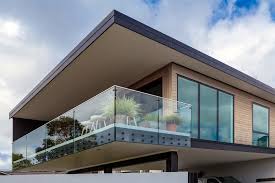Glass balconies have become a symbol of modern architecture, offering a sleek and elegant aesthetic that seamlessly integrates with contemporary design concepts. These transparent structures not only enhance the visual appeal of a building but also contribute to an open and airy atmosphere. In this article, we’ll explore the charm, design considerations, benefits, and the growing popularity of glass balconies in the realm of architecture.
The Allure of Glass Balconies:
- Contemporary Aesthetics: Glass balconies exude a contemporary and minimalist aesthetic that appeals to those seeking a sleek and sophisticated look for their homes or commercial spaces. The use of transparent materials creates a sense of openness, allowing for unobstructed views and a seamless connection between indoor and outdoor spaces.
- Maximized Natural Light: One of the key advantages of glass balconies is their ability to maximize natural light. The transparent nature of glass allows sunlight to flood the interior spaces, creating a bright and uplifting ambiance. This is particularly beneficial for creating well-lit living areas and promoting a sense of openness.
- Panoramic Views: Glass balconies provide unobstructed views of the surroundings, offering residents or occupants a panoramic vista of the landscape. Whether it’s a city skyline, a lush garden, or a scenic waterfront, the use of glass enhances the overall visual experience.
- Architectural Versatility: Glass balcony seamlessly integrates with various architectural styles. Whether used in a modern urban dwelling, a coastal retreat, or a countryside estate, glass complements diverse design concepts and adapts to the overall aesthetic of the building.
Design Considerations for Glass Balconies:
- Safety Measures: Safety is a paramount consideration when designing a glass balcony. Tempered or laminated glass is commonly used to ensure strength and durability. Additionally, building codes may stipulate height requirements for balustrades or railings to prevent accidents.
- Framing Options: Glass balcony can be framed or frameless, depending on the desired aesthetic. Framed glass balconie may use materials like stainless steel or aluminum for support, while frameless options offer a seamless, almost invisible appearance.
- Privacy Considerations: While the transparency of glass is a key feature, privacy considerations may arise. Frosted or tinted glass, as well as strategically placed panels, can address privacy concerns while still allowing for ample natural light.
- Maintenance: Glass balconies require regular cleaning and maintenance to preserve their clarity and appearance. While glass is relatively easy to clean, factors like location, weather conditions, and environmental elements may influence the frequency and type of maintenance required.
Benefits of Glass Balconies:
- Enhanced Aesthetics: Glass balconies contribute to the overall visual appeal of a building. The sleek and transparent design adds a touch of sophistication and modernity, making the structure stand out in architectural landscapes.
- Increased Property Value: The use of glass balconies can enhance the market value of a property. Potential buyers or tenants often appreciate the modern and stylish look that glass features bring to a building, making it a sought-after characteristic in the real estate market.
- Natural Light and Well-being: The abundance of natural light facilitated by glass balconies contributes to the overall well-being of occupants. Exposure to natural light has been linked to improved mood, productivity, and a sense of well-being.
- Visual Connection to Outdoors: Glass balconies create a seamless visual connection between indoor and outdoor spaces. This connection not only enhances the overall aesthetics but also allows residents to feel more connected to nature, even when inside.
Growing Popularity of Glass Balconies:
- Modern Architectural Trends: Contemporary architectural trends favor clean lines, minimalism, and a sense of openness. Glass balconies align with these trends, making them a popular choice among architects and homeowners looking to create visually striking and modern structures.
- Urban Living Spaces: In urban settings where space is often limited. Glass balcony provide an effective solution for maximizing natural light and creating a sense of spaciousness. The transparent nature of glass also allows for unobstructed views of the cityscape.
- Luxury Residences: Glass balcony are often associated with luxury residences and high-end developments. The use of premium materials and the sleek design contribute to the upscale and sophisticated image of these properties.
- Customization Options: The versatility of glass allows for various customization options. From different types of glass to frame designs. Homeowners and architects can tailor glass balcony to suit specific preferences and design requirements.
Conclusion: A Transparent Statement of Modernity
In conclusion, glass balconies represent a transparent statement of modernity and sophistication in architecture. Their ability to seamlessly blend indoor and outdoor spaces. Maximizing natural light, and contributing to a sleek aesthetic has led to their growing popularity in contemporary design. As the architectural landscape continues to evolve. Glass balconies stand as a symbol of innovation and elegance, offering a timeless appeal to those who appreciate the marriage of form and function.

